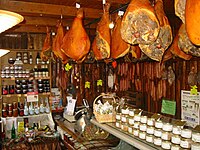
Photo from wikipedia
Sophorose is currently the most effective inducer of cellulase production by Trichoderma reesei; however, the use of byproduct sophorose from the stevioside acid hydrolysis process has not been developed. In… Click to show full abstract
Sophorose is currently the most effective inducer of cellulase production by Trichoderma reesei; however, the use of byproduct sophorose from the stevioside acid hydrolysis process has not been developed. In this study, stevioside was hydrolysed with different concentrations of HCl to obtain isosteviol and a mixture of glucose and sophorose (MGS). Isosteviol showed good inhibitory effects on the growth of Aspergillus niger, Saccharomyces cerevisiae and Escherichia coli after separation. At the same time, MGS, as a byproduct, was evaluated for cellulase production to determine the feasibility of this approach. MGS was compared with common soluble inducers, such as lactose, cellobiose, and a mixture of glucose and β-disaccharide (MGD), and induced higher cellulase production than the other inducers. The cellulase activity induced by MGS was 1.64- and 5.26-fold higher than that induced by lactose and cellobiose, respectively, and was not significantly different from that induced by MGD. The crude enzyme using MGS as an inducer with commercial β-glucosidase was further tested by hydrolyzing NaOH-pretreated corn stover with 5% solid loading, and 33.4 g L−1 glucose was released with a glucose yield of 96.04%. The strategy developed in this work will be beneficial for reducing inducer production cost through a simple stevia glycoside hydrolysis reaction and will contribute to studies aimed at improving cellulase production using soluble inducers for easier operation in industrial-scale cellulase production.
Journal Title: RSC Advances
Year Published: 2022
Link to full text (if available)
Share on Social Media: Sign Up to like & get
recommendations!